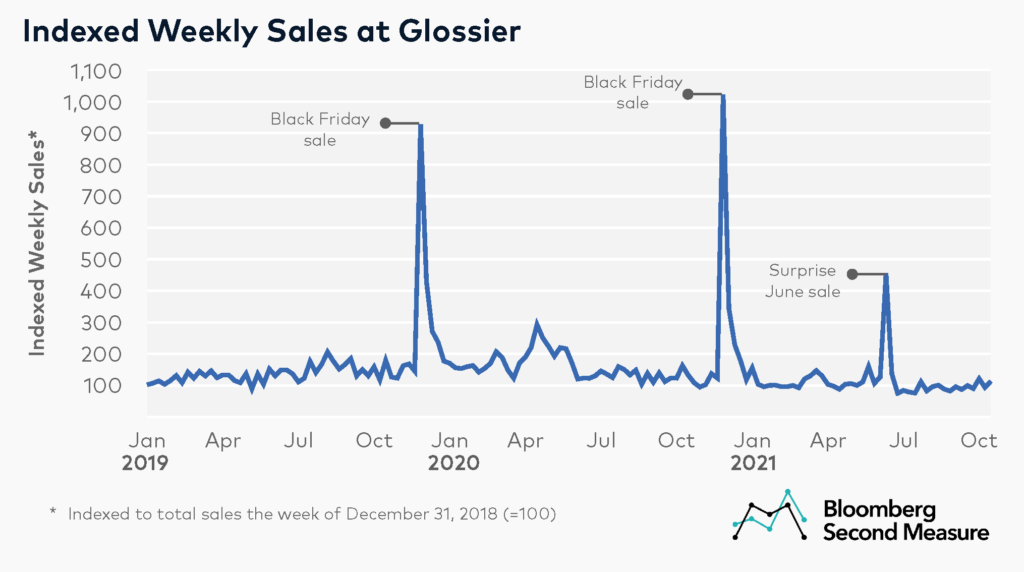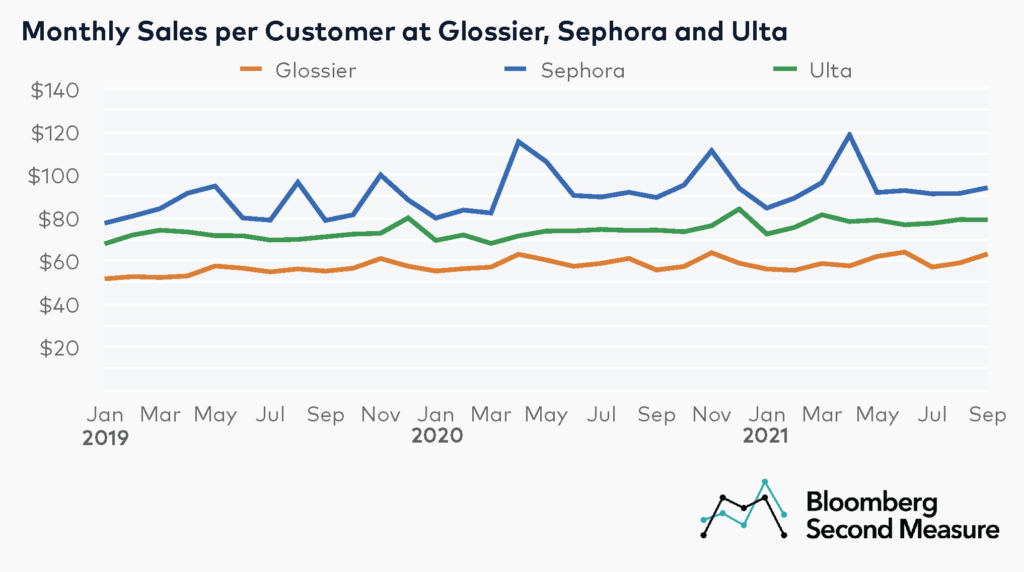NOTE: Bloomberg Second Measure launched a new and exclusive transaction dataset in July 2022. Our data continues to be broadly representative of U.S. consumers. As a result of this panel change, however, we recommend using only the latest posts in assessing metrics, and do not support referring to historical blog posts to infer period-over-period comparisons.
Glossier—the DTC beauty company that recently raised $80 million in Series E funding—has historically held one major sale each year, coinciding with Black Friday and Cyber Monday. Consumer transaction data reveals that Glossier’s sales the week of Black Friday are continuing to grow year-over-year. At the same time, a comparative analysis of other major beauty retailers found that Sephora’s sales events correspond with a sharper increase in monthly sales per customer compared to sales events at Glossier and Ulta Beauty.

In 2019, 16 percent of Glossier’s annual sales occurred during the weeks of Black Friday and Cyber Monday. The following year, that percentage was roughly the same, at 15 percent of annual sales. A closer look reveals that sales for the week including Black Friday were 10 percent higher in 2020 compared to the same week in 2019. However, sales for the week including Cyber Monday were 21 percent lower year-over-year. As in years past, Glossier is expected to launch another Black Friday/Cyber Monday sale in 2021.
In a departure from its previous strategy of focusing on one sales event for the year, Glossier also launched its first-ever Friends of Glossier sale during the summer of 2021, specifically the weekend of June 12. Sales during that week grew 263 percent compared to the week before, and were also 275 percent higher year-over-year.
Aside from sales events, the other notable boost in Glossier sales over the past few years occurred at the beginning of the pandemic. April 2020 sales were 96 percent higher than in 2019, but sales dipped again to pre-pandemic levels a few months later.
How does average sales per customer at Glossier stack up against major beauty retailers during sales events?
Glossier’s average monthly sales per customer remain relatively consistent, even during key sales events like Black Friday. The average sales per customer at Glossier was $61 in November 2019—8 percent higher than the previous month—and $64 in November 2020—11 percent higher than the previous month.

By contrast, multinational personal care and beauty retailer Sephora experiences significant upticks in its average sales per customer (for U.S. customers) during its sales events, including Black Friday. In November 2019, the average sales per customer at Sephora grew 23 percent month-over-month and the average sales per customer in November 2020 grew 17 percent month-over-month. Sephora is also known for its seasonal VIB sales events—typically in April and sometimes in August—which correspond with a similar boost in average sales per customer.
While Sephora and Glossier see higher sales per customer in November, Ulta experiences its most noticeable uptick in sales per customer in December. In both December 2019 and December 2020, the average sales per customer at Ulta increased 10 percent compared to the prior month.
Among the three beauty companies, Glossier has the lowest sales per customer throughout the year. In September 2021, Glossier customers spent an average of $63, compared to $79 at Ulta and $94 at Sephora.
What’s next for Glossier?
Although Glossier permanently closed its New York and Los Angeles stores at the beginning of the pandemic, the company has plans to expand into retail again. In August 2021, Glossier opened its new Seattle store and will launch two more stores in Los Angeles and London within the next several months. Glossier has also undergone some leadership changes, recently bringing on a new CFO and Chief Commercial Officer.
*Note: Bloomberg Second Measure regularly refreshes its panel and methods in order to provide the highest quality data that is broadly representative of U.S. consumers. As a result, we may restate historical data, including our blog content.
